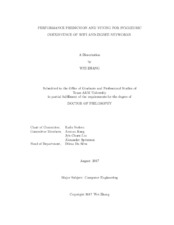| dc.description.abstract | Due to the explosive deployment of WiFi and ZigBee wireless networks, 2.4GHz ISM bands (2.4GHz-2.5GHz) are becoming increasingly crowded, and the co-channel coexistence of these two networks is inevitable. For coexistence networks, people always want to predict their performance (e.g. throughput, energy consumption, etc.) before deployment, or even want to tune parameters to compensate unnecessary performance degradation (owing to the huge differences between these two MAC protocols) or to satisfy some performance requirements (e.g., priority, delay constraint, etc.) of them. However, predicting and tuning performance of coexisting WiFi and ZigBee networks has been a challenging task, primarily due to the lack of corresponding simulators and analytical models.
In this dissertation, we addressed the aforementioned problems by presenting simulators and models for the coexistence of WiFi and ZigBee devices. Specifically, based on the energy efficiency and traffic pattern of three practical coexistence scenarios: disaster rescue site, smart hospital and home automation. We first of all classify them into three classes, which are non-sleeping devices with saturated traffic (SAT), non-sleeping devices with unsaturated traffic (UNSAT) and duty-cycling devices with unsaturated traffic (DC-UNSAT). Then a simulator and an analytical model are proposed for each class, where each simulator is verified by simple hardware based experiment. Next, we derive the expressions for performance metrics like throughput, delay etc., and predict them using both the proposed simulator and the model. Due to the higher accuracy of the simulator, the results from them are used as the ground truth to validate the accuracy of the model. Last, according to some common performance tuning requirements for each class, we formulate them into optimization problems and propose the corresponding solving methods. The results show that the proposed simulators have high accuracy in performance prediction, while the models, although are less accurate than the former, can be used in fast prediction. In particular, the models can also be easily used in optimization problems for performance tuning, and the results prove its high efficiency. | en |


